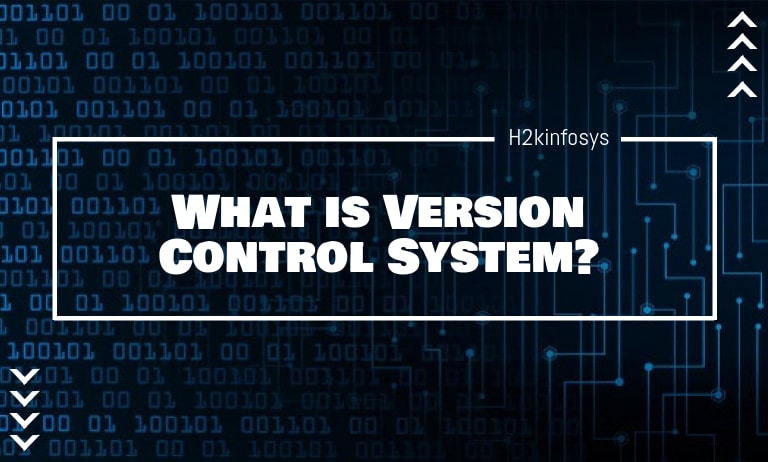A version control system is a software used to record changes to a file or set of files over time. It allows you to work with other programmers also. It is a collection of software tools that help a team manage the changes in source code. It uses a special database to keep records of every modification to the code. Developers can easily compare earlier versions of the code with an older version to fix the issues.
Advantages of the Version Control System:
The Version Control System is helpful and beneficial in software development; developing software without using version control is unsafe. It provides the backups for uncertainty. Version control systems also offer a speedy interface to developers and allow software teams to preserve the efficiency and agility according to the team.
Some main benefits of having a version control system are:
- Complete change history of the file
- Works Simultaneously
- Branching and merging
- Traceability
Types of Version Control System:
- Localized version Control System
- Centralized version control systems
- Distributed version control systems
Localized Version Control Systems:
The localized version control system is a common approach because of its simplicity, but it may lead to a higher chance of error. In this method, you may forget which directory you are in and accidentally write to the wrong file or copy you do not want to.
To overcome this issue, programmers developed local VCSs that had a simple database. These databases kept all the changes to files under revision control. It keeps local copies of the files.
The main drawback of Local VCS is that it has a single point of failure.
Centralized Version Control System:
The developers need to collaborate with other developers on other systems, and the localized version control system failed in this case. To overcome this problem, Centralized Version Control Systems were developed.
These systems have a single server containing the versioned files, and some clients can check out files from a central place.
Centralized version control systems have many benefits over local VCSs.
- Everyone on the system will have information about the work that others are doing on the project.
- Administrators have control over other developers.
- It will be easy to deal with a centralized version control system than a localized version control system.
It also has the same drawback that it also has a single point of failure.
Distributed Version Control System:
Centralized Version Control System use a central server to store the entire database and team collaboration. However, because of single-point failure, which means the failure of the central server, developers do not prefer it. Therefore, the Distributed Version Control System is developed.
In a Distributed Version Control System (like Git, Mercurial, Bazaar, or Darcs), the user has a local copy of a repository. Therefore, the clients do not just check out the latest snapshots of the files, even if they can fully mirror the repository. The local repository comprises of all the files and metadata present in the main repository.
DVCS also allows automatic management branching and merging. It speeds up the most operations except pushing and pulling. It enhances the ability to work offline and does not depend on a single location for backups. If the server stops and other systems were associated via it, that server could restore any client repositories. Every checkout contains a full backup of all the data.
These systems do not necessarily rely on a central server to store all the versions of project files.
Difference between the Centralized Version Control System (CVCS) and Distributed Version Control System (DVCS):
Centralized Version Control Systems uses client/server architecture. In centralized Version Control System, one or more client systems are connected directly to a central server. However, in the Distributed Version Control Systems, systems use peer-to-peer architecture.
| Centralized Version Control System | Distributed Version Control System |
| In CVCS, The repository is placed in one place and delivers information to many clients. | In DVCS, Every user contains a local copy of the repository in place of the central repository on the server-side. |
| It is based on the client-server approach. | It is based on the client-server approach. |
| It is based on the concept of the central repository. | It is flexible and based on the concept that everyone has their repository. |
| In CVCS, the latest code is provided by the server to all the clients. | In DVCS, the user can check out the code, and can check the central repository. |
| CVCS is easy to administrate and has additional control over users and access by its server from one place. | DVCS is fast comparing to CVCS, as you don’t have to interact with the central server for every command. |
| The popular tools of CVCS are SVN (Subversion) and CVS. | The popular tools of DVCS are Git and Mercurial. |
| CVCS is easy to understand for beginners. | DVCS has some complex process for beginners. |
| If the server fails, No system can access data from another system. | if any server fails and other systems were collaborating via it, that server can restore any of the client repositories |
What is GIT?
Git is an open-source and distributed version control system designed to handle minor to major projects with high speed and efficiency and co-ordinate the work among the developers. The version control system allows us to track and work together with our team members at the same workspace.
Git is the foundation of many services such as GitHub and GitLab, but we can use Git without using any other Git services. Git can be used both privately and publicly.
Git was created in 2005 by Linus Torvalds to develop Linux Kernel and is also used as an important distributed version-control tool/system for the DevOps.
Git is easy to learn, has fast performance, and is superior to other SCM tools such as Subversion, CVS, Perforce, and ClearCase.
Features of GIT:
- Open Source: Git is an open-source tool and is released under the GPL (General Public License) license.
- Scalable: Git is scalable, which means that when the number of users increases, the Git can easily handle such situations.
- Distributed: GIT is distributed, which means that instead of switching the project to another machine, we can create a copy of the entire repository. Also, instead of having only one central repository that you send changes to, every user can have their own repository that contains the entire commit history of the project. We don’t need to connect to the remote repository; the change is just stored on our local repository. When required, we can push these changes to a remote repository.
- Security: Git is secure as it uses the SHA1 (Secure Hash Function) to name and identify objects within its repository. Files and commits can be checked, and retrieved by its checksum at the time of checkout. It stores its history so that the ID of particular commits depends upon the complete development history leading up to that commit. Once it is released, one cannot make changes to its old version.
- Speed: Git is very fast, so that it can complete all the tasks in a while. Almost all the git operations are done on the local repository, so it provides a huge speed. Also, a centralized version control system continuously communicates with a server somewhere.
The performance tests conducted by Mozilla showed that it was extremely fast compared to other version control systems (VCSs). Fetching the version history from a locally stored repository is faster than fetching it from the remote server. The core/basic part of Git is written in C that ignores runtime overheads associated with other high-level languages.
Git was initially developed to work on the Linux kernel; hence, it is capable enough to handle large repositories effectively. From the starting, speed and performance have been Git’s primary goals.
- Supports non-linear development: Git also supports seamless branching and merging that helps visualize and navigate a non-linear development. A branch in a Git represents a single commit. We can also construct the full branch structure using its parental commit.
- Branching and Merging: These are the important features of Git that makes it different from the other SCM tools. Git also allows the creation of multiple branches without affecting each other. We can easily perform tasks such as creation, deletion, and merging on branches, and these tasks take only a few seconds. Below are some of the features of branching:
- We can create an individual branch for a new module of the project, and can commit and delete it whenever we want.
- We can have a production branch that always has what goes into production and merged for testing in the test branch.
- We can also create a demo branch for the experiment and check if it is working or not. We can also remove it if required.
The core advantage of branching is that if we want to push something to a remote repository, we do not need to push all the branches. We can select a few of them, or all of them together.
- Data Assurance: The Git data model also ensures the cryptographic integrity of every unit of the project. It provides a unique commit ID for every commit through an SHA algorithm. We can also retrieve and update the commit by using commit ID.
- Staging Area: The Staging area is a unique functionality of Git and can be considered as a preview of our next commit, in addition, an intermediate area where commits can be formatted and reviewed before completion. When you perform a commit, Git takes changes that are in the staging area and make them as a new commit. We are allowed to add and remove the changes from the staging area. The staging area is considered as a place where Git stores the changes.
Although, Git does not have a dedicated staging directory where it can store some objects representing the file changes (blobs). Instead of it, Git uses a file called index.
Another feature of Git is that it is possible to quickly stage some of the files and commit without committing other modified files in the working directory.
- Maintain the clean history: Git also facilitates with Git Rebase and is one of the most helpful features of Git. It retrieves the latest commits from the master branch and puts the code on top of that maintaining a clean history of the project.
Advantages of GIT:
A version control system allows us to keep track of all the changes that we make in our project’s files. Every time we make changes in an existing project’s files, we can push those changes to a repository. Other developers can pull your changes from the repository and continue to work with the updates that you have added to the project files.
The main benefits of using Git are:
- Saves Time: Git is lightning fast technology and each command takes only a few seconds to execute, and thus saving a lot of time compared to login to a GitHub account and find out its features.
- Offline Working: One of the essential benefits of Git is that it also supports offline working. If we face internet connectivity issues, it will not affect our work. In Git, we can almost do everything locally. Comparatively, other CVS such as SVN is limited and prefer the connection with the central repository.
- Undo Mistakes: One additional advantage of Git is that we can Undo mistakes. Sometimes the undo can act as a savior option for us.
- Track the Changes: Git also facilitates with some exciting features like Diff, Log, and Status that allows us to track changes so that we can check the status, and compare our files or branches.





























